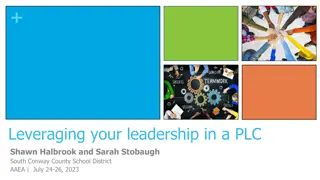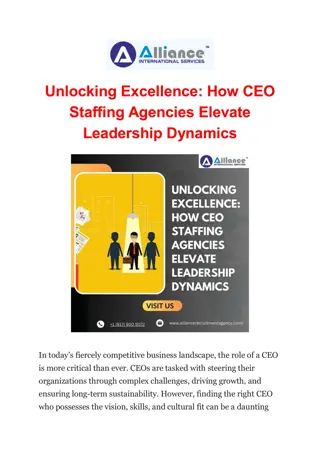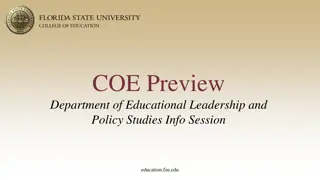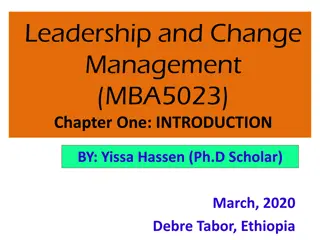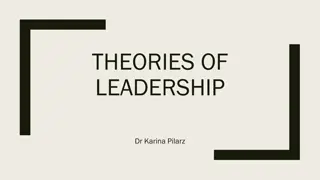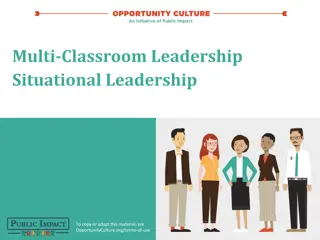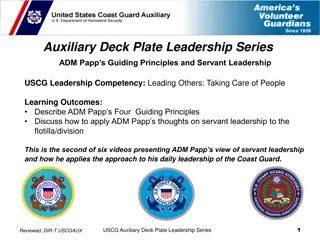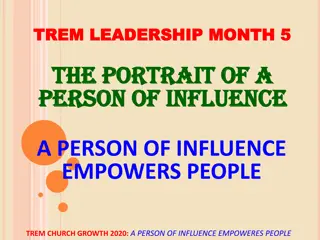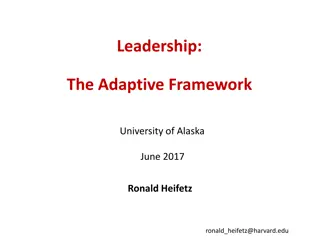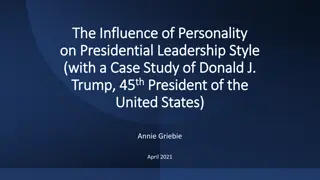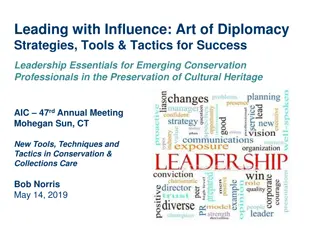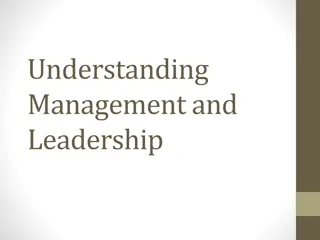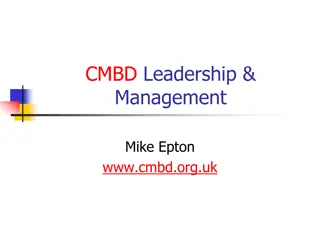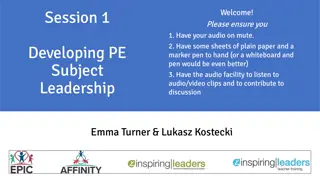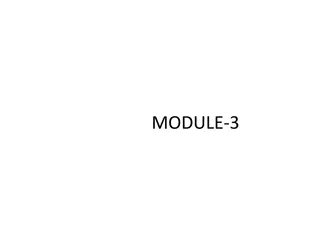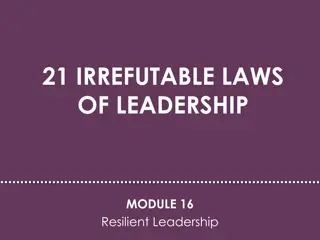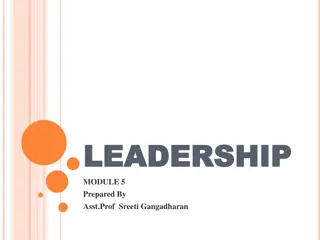Understanding the Dynamics of Educational Leadership and the Influence of Gurus
Exploring the evolving landscape of educational leadership, this research delves into the interplay between fads, fashions, and gurus in school leadership. Through an analysis of the guru industry, guru-follower relationships, and management trends, the study aims to uncover the expectations shaping educational leadership practices. By examining the roles of various stakeholders, including consultants, academics, and school leaders, insights into the complexities of leadership dynamics are revealed.
Download Presentation

Please find below an Image/Link to download the presentation.
The content on the website is provided AS IS for your information and personal use only. It may not be sold, licensed, or shared on other websites without obtaining consent from the author. Download presentation by click this link. If you encounter any issues during the download, it is possible that the publisher has removed the file from their server.
E N D
Presentation Transcript
Nera 2019 Fads, fashions, and gurus in school leadership interrelations between gurus and followers Lars Frode Frederiksen Jakob Ditlev B je University of Southern Denmark 1
Context Many and varying expectations of today s school leaders (Robinson, 2015; Courtney & Gunter, 2015) In the latest reform of the Danish primary school (Folkeskole), one can find expressions stating that the school leader must: perform , compose , involve , decide offer , initiate , evaluate , permit , etc. (Ministry of Education, 2018) As such, the school leader has become responsible/made accountable of the individual school s performance and general well-being 2
Research question Which expectations of educational leadership does the guru-industry constitute, and how is the guru- industry itself constituted by such expectations? 3
Structure 1. Research and literature on fads, fashions, and gurus in school leadership 2. Guru theory 3. Analysis of Professional Learning Communities (PLC s) 4. Conclusion and discussion 4
Guru, fashion og fads Management fashion: a relatively transitory collective belief, disseminated by management fashion setters, that a management technique leads to rational management progress (Abrahamson 1996) 5
Guru industry A two-headed phenomenon The one consists of the consultants industry and other management gurus The other consists of the journalistic and academic commentators Another approach is to study the tendency as a relationship between the suppliers of management concepts, fashions, and fads and managers as users with needs for managerial support Managers are not passive receivers 6
The guru-follower relationship Theoretical approaches to understanding the guru-follower relationship A. Symbolic interactionism: A play/performance in everyday life The audience creates the guru as much as the guru creates the audience Front stage/backstage performance: involves risk if back stage is exposed; the show may break down B. Anthropological perspectives: witchdoctor-client relationship A way of organizing hope/faith in a dangerous world C. Guru s are selling a brand. Leaders are (actively) buying a brand (Collins) Guru-theories are not beside leadership it is a part of leadership It offers a means of dealing with ambiguity D. Narrative and discourse theory: Storytellers & listeners 7
Current fashions and gurus in school leadership Student centred leadership (Robinson, 2015) and Professional learning communities (e.g. Albrechtsen, 2016) We will attempt to study the guru-follower relationship in connection to these phenomena We believe a case study of these may tell a broader story of how school leadership is currently constituted in relation to omnipresent hopes and expectations and vice versa 8
What is PLC? An idea? A concept? A phenomenon? A thing containing different dimensions? (see below) A commodity? Albrectsen (2016) refers to PLC s in all the above ways The vagueness of PLC leads to a certain mystique which may lead to heightened expectations 9
Who talk about and promote PLCs? Applied research(ers), e.g. in the UC s; not so much unapplied academics Advisors, consultants, policy developers According to Clark and Salaman (1996), gurus are not classic professionals in that they: Don t refer to a common, authoritative knowledge base checked and controlled by other professionals and professional associations Don t go through selection, qualification, and certification processes Gurudom is based on the identification of a set of ideas with particular individuals (e.g. student centered leadership) otherwise gurus would not be gurus Gurus work is aimed at hearts and minds, not structures and systems (p. 86) 10
To whom are PLCs adressed? Multiple and therefore vague receivers (followers) Both teachers and leaders, depending on who talks/promotes No clear distinctions are made between teachers and leaders No conflict of interest is mentioned No discussions of occupational professionalism (PLC s for teachers) as opposed to organizational professionalism (PLC s for leaders) However: rhetoric sometimes changes when respectively teachers and leaders are (indirectly) addressed: Professional capital teachers (Hargreaves) Capacity building leaders (Jensen, 2016) 11
How are PLCs promoted? (1) Language: Narrative and metaphoric (e.g. teaching at a crossroad, with deep abysses at each side ) Seductive/missionizing (e.g. by reference to Mandela as another guru) With a touch of science (but not simply descriptive/analytic) Many empty signifiers and superlatives involved (e.g. improve, support, strengthen, reform, inform, encourage, have positive implications, create active participation) Some antagonisms (e.g. privatized teaching, business capital) All in all: multiple ways of promoting the phenomenon 12
How are PLCs promoted? (2) Feelings, sentiments, affects aroused among followers (in this case us as readers): A sense of importance (not unimportant) Energetic not boring Spell-binding Challenging/confronting Non-objective Uplifting, faith-promoting (c.f. Malinowski) A sense of righteousness (the wrong way to go or the right way to go in education) A sense of conviction All in all: the literature is performing 13
Conclusion Which expectations of educational leadership do gurus (PLC s) constitute? Schools can and should be led as collaborating, learning, and non-political organizations Right action may lead to right results. Problems can be fixed How are gurus (PLC s) themselves constituted by such expectations? A market is established demand is guarantied A reciprocal creation and consumption of hope is connecting gurus and followers a never-ending viscous circle 14
Discussion Expectations increase infinitively More complex to be a teacher or a leader Accountability replaces responsibility Unintentional consequences What happens if expectations are not realized and problems cannot be handled as prophesied by the gurus and wished by the followers? 15


